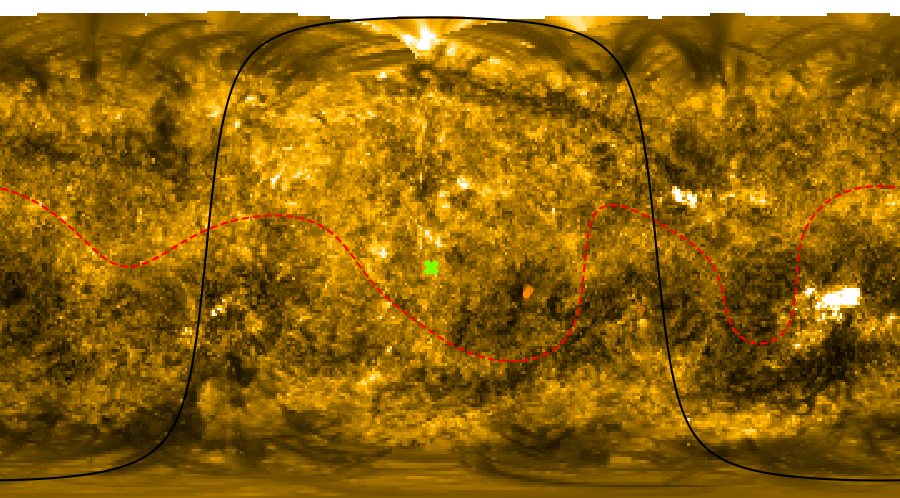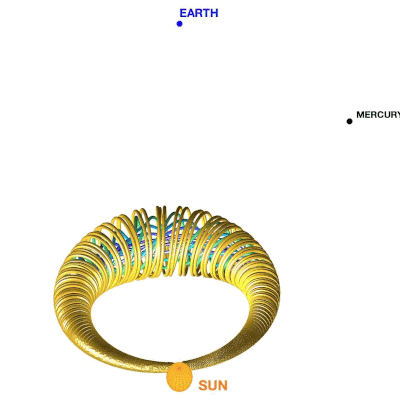This page presents a number of tools that were developed to support research in space weather. They include tools to track the onset of CMEs and model their propagation, nowcasting and forecasting tools of the coronal magnetic field and the solar wind.
SOLAR CORONA FORECAST
Magnetic Connectivity Forecast
Find how an object is connected magnetically with the surface of the Sun. This connectivity is computed using different observations and models
Storms Team
The Magnetic Connectivity Tool computes magnetic connectivity between a spacecraft or a planet and solar surface for multiple observed data and multiple models.
For each connectivity, assess uncertainty.

- Results are available everyday at midday and midnight in UTC standard. Daily data is used, including photospheric magnetograms and Extreme UV Carrington maps
- A forecast mode finds magnetic connectivity up to 3 days in the future thanks to predictive magnetograms
- Computation are based on observations (magnetograms) coupled with heliospheric models (Parker spiral, MHD) and coronal models (PFSS, NLFFF)
- Connectivity results are displayed on the projected solar surface, along with different backgrounds (Extrem UV map, magnetogram). A file containing the list of all connectivity points with their associated density is also provided
SOLAR WIND FORECAST
Heliocast
Real time 3D MHD inner heliosphere model, based on multi-source coronal models. Nowcast and forecast of solar wind standard features are coming soon
Developer: Victor Reville (victor.reville[at]irap.omp.eu)
Heliocast is a service that provides nowcast and forecast of the structure of the inner heliosphere: wind speed, temperature and magnetic field through 3D MHD modeling between 0.1 and 1 AU. Inner boundary conditions are set through STORMS coronal models : PFSS, Multi-VP or 3D MHD model. Forecasting window can be up to one Carrington rotation.
SOLAR WIND FORECAST
1-D Solar Wind Forecast
Real-time forecasting tool of the state of the solar wind at Earth or at different spacecraft
Developer: Rui Pinto (rui.pinto[at]irap.omp.eu)
SWiFT-FORECAST is a real-time solar wind forecasting tool based on the SWiFT (Solar Wind Flux-Tubes) modelling pipeline. Its goal is to continuously provide forecasts (with a lead time of at least a few days) of the state of the solar wind at Earth or at different spacecraft.
The SWiFT-FORECAST back-end performs quick and robust simulations of the whole chain of processes that determine the state of the solar wind all the way from the surface of the Sun to the heliosphere. The pipeline couples a series of data-driven physical models (without resorting to empirical methods), and can combine different magnotograms sources (WSO, SOLIS, GONG, ADAPT), coronal field reconstruction methods (PFSS, NLFFF), wind models (MULTI-VP), and heliospheric propagation models (CDPP/AMDA 1D MHD). The front-end webpage currently provides a daily-updated a set of bulk physical parameters of the solar wind (speed, density, temperature, magnetic field) at point L1 up to 6-7 days in advance, and compares them with in-situ data (DSCOVR spacecraft). Future improvements will include other targets (planets and s/c), ensemble forecasting based on different model and dataset combinations, and forecast skill metrics.

- Continuous solar wind forecasting (lead time up to one week) at Earth, L1 or spacecraft positions
- Pipeline that couples physics-based data-driven models (surface magnetic field, corona and solar wind)
- Comparison with remote sensing and in-situ data
CME FORECAST
Nowcasting CME initiation
Automated calculation of the CME-initialization parameters from near-real time SDO/AIA and SDO/HMI data (under development)
Developer: Kévin Dalmasse (kevin.dalmasse[at]irap.omp.eu)
A tool is currently under development for the automated calculation of the CME-initialization parameters from the exploitation of the near-real time SDO/AIA 1600 A imaging and the pre-CME SDO/HMI magnetogram. The 2-minute cadence AIA1600 data will be used for the automated extraction of the flare-ribbons timeseries. The photospheric footpoints and the tilt of the CME magnetic flux rope will be derived from the flare-ribbons geometry right before the flare-ribbons peak intensity, while the CME poloidal magnetic flux injection will be approximated as the time-derivative of the flare-ribbons magnetic flux.
This tool will also work in a semi-automated version in which the CME magnetic flux rope tilt will be computed from the photospheric footpoints of the CME as identified by the user from one of AIA1600, AIA304, AIA171, or AIA34 pre-CME data.

CME FORECAST
Flux-rope propagation tool
Specify CME properties near the Sun and forecast the properties of ICMEs at any point in the inner heliosphere
Developer: Alexis Rouillard (alexis.rouillard[at]irap.omp.eu)
The CME forecast tool can be used to specify CME properties near the Sun and forecast the properties of ICMEs at any point in the inner heliosphere. The tool models in a very simple manner the forces acting on magnetic flux rope erupting in the solar atmosphere and propagating in the solar wind. Output of the model include the magnetic field and plasma components measured by a spacecraft impacted by a CME. The front-end interface is java-based and was funded by the CDPP, it can be launched directly from your browser.

- Near the Sun, the structure is initialized with a set of input parameters (3-D orientation, poloidal magnetic flux, strength of confinement field)
- A 3D magnetic flux rope is then generated and propagated from the Sun to any point of interest (planet, probe) in the inner heliosphere (takes 4 minutes at most)
- If the rope passes by that point, the in-situ signature of the flux rope is reconstructed and can be directly compared to in-situ measurements.
CME FORECAST
CME shock forecasting tool
Coming soon !
Developer: Athanasios Kouloumvakos (akouloumvakos[at]irap.omp.eu)
Illya Plotnikov (illya.plotnikov[at]irap.omp.eu)
Coming soon !